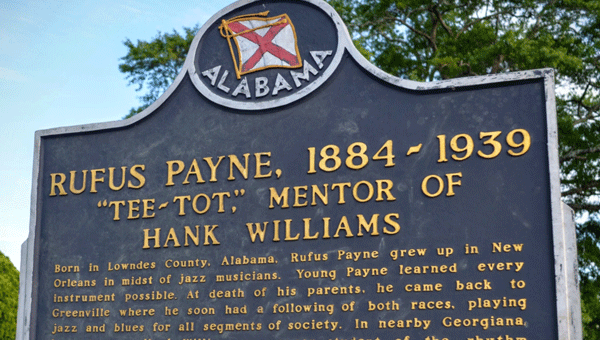Tee-Tot a mentor to legendary musician
Published 5:29 pm Friday, May 12, 2017

- This monument for Rufus “Tee-Tot” Payne, paid for by Hank Williams, Jr. and members of the Grand Ole Opry stands just outside Lincoln Cemetery in Montgomery. Payne is buried there in an unmarked pauper’s grave.
His name was Rufus, but most everyone knew him by his nickname, “Tee-Tot,” a derivative of “tee-totaler.” It was a sly wink at his fondness for carrying a flask filled with tea, “ the house wine of the South,” mixed with a generous dollop of local moonshine.
He died in obscurity in his mid-50s in a Montgomery charity hospital. Buried in an unmarked pauper’s grave in 1939, Tee-Tot’s death certificate recorded his parentage and date of birth as “unknown.”
Yet Rufus Tee-Tot Payne played an integral role in the life of one of the nation’s most beloved and influential entertainment legends—Butler County’s native son, Hank Williams, Sr.
According to Alabama blues historian Alice Harp, Payne himself was not, as frequently reported, born in Greenville, but came into this world on the Payne Plantation in Sandy Ridge in Lowndes County in the year 1884.
At the age of six, Payne and his family left Sandy Ridge and moved to New Orleans. There he grew up learning to play the jazz and blues music that permeated the Big Easy’s culture.
Payne returned to Alabama in 1915, performing at a number of venues in Montgomery, Lowndes and Butler counties. It wasn’t just smokey clubs and noisy juke joints where he performed, however; he was also welcomed into the homes of well-to-do whites in the area, playing and singing during elegant afternoon tea parties and other social events. Unlike the image of a scruffy, hunch-backed street musician painted by many who have written about him, historian Harp describes Payne in those days as a downright dapper figure, a compact, handsome man who always dressed in suits.
During the early 30s, in the depths of the Great Depression, Payne was living in south Butler County. Coincidentally, so was a lean and lanky white boy with a shy smile. Hiram Williams was the boy’s name, and his mother Lillie ran a boarding house in Georgiana.
Hiram’s family was like so many others in those days, moving every few years and struggling to make ends meet during hard times. His father Lon, a railroad engineer for W.T. Smith Lumber, had never fully recovered from a severe injury suffered during the first World War. A brain aneurysm would ultimately keep Lon hospitalized for eight years in Louisiana, missing much of Hiram’s childhood.
Hiram himself suffered from a form of spina bifida that made playing sports or engaging in hard physical labor difficult. He did what he could to help out his family financially, offering shoeshines and selling peanuts to the folks coming and going at Georgiana’s busy railroad station after school and during the summer. Hiram was bright and had plenty of energy—and he was looking for an outlet.
He would find it in music.
In the first half of the 20th century, the Deep South birthed many influential musicians in so many genres, including blues, jazz, folk, gospel and what was known as “hillbilly” music, the forerunner of what we now call country music.
And this was a time when many folks couldn’t afford a phonograph or a radio. Folks entertained themselves and each other with musical jam sessions.
According to Lillie Williams, she obtained her son’s first guitar for the sum of $3.50, a near-princely sum in Depression days, paid for in small installments.
Hiram struggled trying to learn how to play it on his own. What he really needed was a music teacher.
Tee-Tot had apparently also fallen on harder times by then, performing on the streets of Georgiana to earn money so he could keep his flask filled and some food in his belly.
Hiram was intrigued by the black musician and started following him around, hoping to persuade the man to give him lessons. It was a time of racial divide. Tee-Tot worried what people would think about this frail-looking but determined white kid dogging his footsteps.
But it was also a time of poverty for blacks and whites alike, and poverty, it has been said, is a great equalizer. So, it seems, is music.
Payne became Hiram’s musical mentor, teaching him about chords and rhythm, bass turns and the beat, yes. But there was more.
Tee-Tot also taught the bashful young Hiram how to project himself on stage, about patter and jokes and showmanship, and the boy never forgot those lessons.
Hiram’s mother fed Payne at her boarding house as partial payment for the lessons, with Hiram giving him a few hard-earned nickels and dimes here and there.
Years later, when Hiram was going by Hank and staying busy turning out hit singles left and right, he told journalists about his old friend and mentor Tee-Tot, giving the black man credit for teaching and guiding him as a budding musician.
When Hank returned to Greenville for a special concert in 1951 and tried to look up Payne, he discovered his mentor was long dead and gone. Payne never knew to what dizzying career heights that skinny, shy kid he taught would climb before passing away at only 29.
No known photos of Payne are in existence today. He never recorded his music. There are large chunks of his life about which we know little. But this much seems clear. It is thanks to Payne’s influence that Williams as songwriter and musician was able to successfully fuse blues, hillbilly and folk into his own unique and unforgettable style.
Williams told the Montgomery Advertiser in 1951 that Rufus Tee-Tot Payne, blues musician and music teacher, gave him “all the music training I ever had.”
Today, a monument paid for by Hank Williams, Jr. and members of the Grand Ole Opry stands just outside Lincoln Cemetery in Montgomery, paying tribute to this remarkable native son of Lowndes County.





